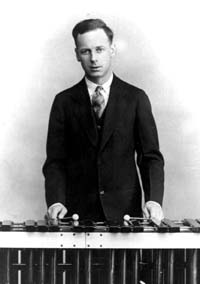George Hamilton Green
Biography
Born: May 23, 1893
Died: September 11, 1970
Country: Omaha, Nebraska, U.S.A.
Studies: Creighton College (1911-13)
Teachers: Ernest Nordon, Sigmond Lansberg
Mention: Inducted into the Percussive Arts Society "Hall of Fame" (1983)[1]
See Also Green Brothers
See Also Kreisler/Green
George Hamilton Green, Jr. (May 23, 1893–1970) was a xylophonist, composer, and cartoonist born in Omaha, Nebraska. He was born into a musical family, both his grandfather and his father being composers, arrangers, and conductors for bands in Omaha. From age four G.H. Green showed a prodigious talent as a pianist; he then took up the xylophone and by the age of eleven was being promoted as the “world’s greatest xylophonist” and was playing for crowds of 7,000-10,000.[1] In 1915, when Green was 22 years old, a review in the United States Musician stated: "He has begun where every other xylophone player left off. His touch, his attack, his technique, and his powers of interpretation in the rendition of his solos being far different than other performers. To say his work is marvelous and wonderful would not fully express it." George Hamilton Green wrote several pieces for solo ragtime xylophone with accompaniment, as well as a xylophone method book which continues to be used by percussion pedagogues across the country. Some of his compositions for xylophone include: "Ragtime Robin", "Cross Corners", "Charleston Capers", "Rainbow Ripples", "Log Cabin Blues", "The Whistler", and "Jovial Jasper"
He was a popular recording artist starting in 1917 with the Edison Company and was employed, along with his two brothers, Joe and Lew Green, as the original sound music crew for Walt Disney’s first three cartoons.
According to Nathaniel Shilkret,[4] Green was not only a "wonderful xylophone artist," but an inventor. Shilkret said that Green designed the vibraphone at Shilkret's request.
Green was an important ragtime composer and authored many pieces that remain standards for the instrument even today.[5] He retired from performing in the late '40's to pursue a successful career in cartooning. Green would die in 1970, just a few years before a revival in the popularity of his ragtime xylophone music, and before his induction into the Percussive Arts Society Hall of Fame in 1983 [6] The rebirth of his music was led members of the NEXUS Percussion Ensemble in the late 1970s. Through their efforts, G.H. Green’s xylophone music has been preserved and remains a relevant part of contemporary percussion pedagogy and performance.
Books for Percussion
Instruction Course for Xylophone: A Complete Course of Fifty Lessons
George Hamilton Green’s Xylophone Rags
New Elementary Studies for Xylophone and Marimba
Works for Percussion
Alabama Moon - Xylophone; Marimba Ensemble
An Indian Story - Xylophone; Marimba Ensemble
Arabian Minute Dance (Dakika Rakis) - Xylophone; Piano
Caprice Valsant - Xylophone; Piano
Charleston Capers - Xylophone; Marimba Ensemble
Chromatic Fox-Trot - Xylophone; Marimba Ensemble
Cross-Corners - Xylophone; Marimba Ensemble
Dotty Dimples - Xylophone; Marimba Ensemble
Fluffy Ruffles - Xylophone; Marimba Ensemble; Band
Frivolity - Xylophone; Marimba Ensemble
Gavotte en Baninant - Xylophone; Piano
Girlfriend's Medley - Xylophone; Piano
Jovial Jasper - Xylophone; Marimba Ensemble
Keep Movin' - Xylophone; Marimba Ensemble
Log Cabin Blues - Xylophone; Marimba Ensemble
Rain - Xylophone; Marimba Ensemble
Rainbow Ripples - Xylophone; Marimba Ensemble
Rajah - Xylophone; Marimba Ensemble
Spanish Waltz - Xylophone; Marimba Ensemble
Stop-Time - Xylophone; Marimba Ensemble
The Humming Bird - Xylophone; Piano
The Ragtime Robin - Xylophone; Marimba Ensemble
The Whistler - Xylophone; Marimba Ensemble
Triplets - Xylophone; Marimba Ensemble
Valse Briliante - Xylophone; Marimba Ensemble
References
